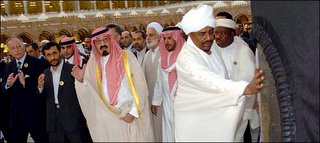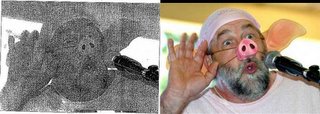EN EL POST ANTERIOR me refería a lo que
escribí en su momento sobre el general Sada. Entre la información adicional que incluí hablé de unas
cintas de 12 horas de duración en las que Saddam supuestamente aparecía hablando con sus más directos colaboradores sobre armas de destrucción masiva, grabadas durante una reunión en su despacho-búnker y que habían sido encontradas tras su derrocamiento. Decía que esas grabaciones iban a hacerse públicas este fin de semana en una conferencia que tiene lugar cada año en Arlington, a las afueras de Washington: la
Intelligence Summit, presidida por
John Loftus, un antiguo agente de inteligencia y analista. Y lo dejé ahí a la espera de confirmación, o por lo menos de informaciones adicionales; me parecía algo curioso que una información supuestamente tan crucial fuera a darse a conocer en
conciliábulo extraoficial en lugar de ser analizado en alguna instancia oficial.
Estaba equivocado, por lo visto; las grabaciones sí se estaban analizando en una instancia oficial: el comité de inteligencia de la Cámara de Representantes, presidido por el congresista Peter Hoekstra, a quien Loftus
había entregado las grabaciones. Y anoche la cadena de televisión ABC, que también ha tenido acceso a ellas,
ha confirmado su existencia y su contenido en un reportaje que ha levantado una buena polvareda:
ABC News has obtained 12 hours of tape recordings of Saddam Hussein meeting with top aides during the 1990s, tapes apparently recorded in Baghdad's version of the Oval Office.
ABC News obtained the tapes from Bill Tierney, a former member of a United Nations inspection team who translated them for the FBI. Tierney said the U.S. government is wrong to keep these tapes and others secret from the public. "Because of my experience being in the inspections and being in the military, I knew the significance of these tapes when I heard them," says Tierney. U.S. officials have confirmed the tapes are authentic, and that they are among hundreds of hours of tapes Saddam recorded in his palace office.
One of the most dramatic moments in the 12 hours of recordings comes when Saddam predicts -- during a meeting in the mid 1990s -- a terrorist attack on the United States. "Terrorism is coming. I told the Americans a long time before August 2 and told the British as well ... that in the future there will be terrorism with weapons of mass destruction." Saddam goes on to say such attacks would be difficult to stop. "In the future, what would prevent a booby-trapped car causing a nuclear explosion in Washington or a germ or a chemical one?" But he adds that Iraq would never do such a thing. "This is coming, this story is coming but not from Iraq."
Also at the meeting was Iraq's Deputy Prime Minister Tariq Aziz, who said Iraq was being wrongly accused of terrorism. "Sir, the biological is very easy to make. It's so simple that any biologist can make a bottle of germs and drop it into a water tower and kill 100,000. This is not done by a state. No need to accuse a state. An individual can do it."
The tapes also reveal Iraq 's persistent efforts to hide information about weapons of mass destruction programs from U.N. inspectors well into the 1990s. In one pivotal tape-recorded meeting, which occurred in late April or May of 1995, Saddam and his senior aides discuss the fact that U.N. inspectors had uncovered evidence of Iraq's biological weapons program--a program whose existence Iraq had previously denied.
El tema se está calentando por momentos, y en
Pajamas Media hemos abierto una sección especial sobre la materia,
WMD Files. Además de recopilar las informaciones que se vayan publicando sobre el tema en medios y blogs, vamos a estar presentes en la Intelligence Summit. Iremos informando de todo lo que ocurra el fin de semana, incluyendo entrevistas en video, pero no nos quedaremos en eso: WMD Files seguirá después con todas las novedades sobre la cuestión. No os lo perdáis.
ACTUALIZACIÓN. Ping pong de enlaces: Emilio Alonso
también escribe sobre el tema (y seguro que también le gusta
lo de Ali Ibrahim al-Tikriti), aunque creo que va "demasiado más allá": las cintas en sí mismas no parecen demostrar que Saddam tuviese armas de destrucción masiva, sino que confirman que el tirano asesino era un riesgo inaceptable para el mundo civilizado. Y si además lo consideramos junto a las dos fuentes (Sada y al-Tikriti) que aseguran que sí las tenía y están en Siria, la cosa está clarísima.











